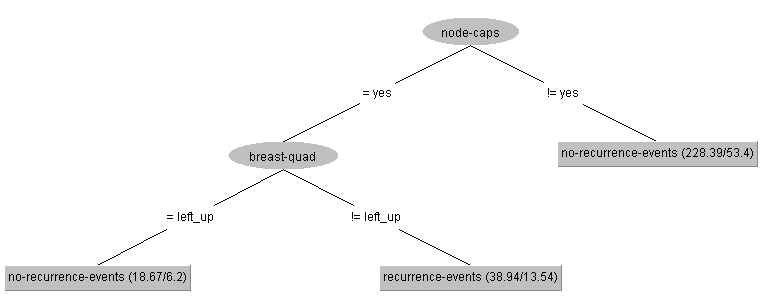I can't find a reference, but the only sensible thing to me is that it operates the same way any sample weighting would: in the information entropy definition
$ -\sum_i p_i \log(p_i) $, where normally $p_i=|C_i|/|C|$, we take the total weights instead of just cardinalities.
The only sensible thing again: the weights are multiplicative. If a node has 0.4 of a row, and that row needs to be subdivided again in a 0.7 vs 0.3 split, then the children have that row with weights 0.28 and 0.12.
This one seems pretty clear from your quote. If the row ends up in four leaves with weights 0.1, 0.2, 0.3, and 0.4, and those leaves get classified as class 1, 2, 3, 1 respectively, then the row gets a total weight for class 1 of 0.1+0.4, weight for class 2 of 0.2, and weight for class 3 of 0.3, and the final classification is class 1. (There's another reasonable approach, I think, if you take the tree to be a soft classifier in the first place. In that case, you'd take the weighted averages of the leaf probabilities.)
I ran an example through weka's implementation of C4.5. I don't think it preserves the information gain calculations, so I can't confirm (1), but (2) and (3) both check out. I'm using the builtin breast cancer dataset, with just the two features node-caps and breast-quad (the only two with any missing values). I turned off pruning, but enforced only binary splits and set minimum leaf node samples to 10 to keep the tree small. To check (2), I've also taken one row with node-caps=missing, breast-quad=right_low, and class=1 and deleted its breast_quad feature; this is now the sole row missing both features. I set the model to evaluate on the training set.

The first split is on node-caps: there are 222 rows with this feature =no, 56 =yes, and 8=missing. The weights then are $56/278\approx 0.201$ and $0.799$.
node-caps=no reports class 0, 228.39 / 53.4.
That $228.39 \approx 222 + 8*0.799$.
As for the $53.4$, we need to check how many no and how many missing are of class 1. That's 51 and 3, respectively, and indeed $53.4 \approx 51 + 3*0.799$.
Using similar calculations for the rest of the tree will allow us to check (2). The node node-caps=yes doesn't give a report since it was split, but we can calculate that it would display $286-228.39=57.61$ and $85-53.4=31.6$. It'll be worth it later to check that the 57.61 is made up of 18 full samples with breast-quad=left_up, 38 full samples with breast-quad!=left_up, and 8 samples with weight 0.201 (of which 3 have left_up, 4 not left_up, and 1 missing).
Now for the second split in this branch; I'll focus on the right one since it is reporting the positive class:
breast-quad!=left_up reports class 1, 38.94 / 13.54.
There are 38 rows without missings in this branch, 4 with node-caps missing but breast-quad!=left_up, and 1 with both features missing. So the total weight of samples not missing breast-quad is 38.804; similarly, in the left side of the split, the weight is 18.603. The one row missing both features should now have weight $0.201 * 38.804 / (38.804 + 18.603) \approx 0.136$. And indeed $38.94 = 38.804+0.136$.
Whew, that's way harder to type out than I expected.
For (3) we look to the confusion matrix to see that 38 rows were classified as positive class. That's just the 38 rows without any missings in the leaf we just finished discussing. The one row missing both features got weight 0.799 in the first-level leaf, 0.065 in the other class-0 leaf, and 0.136 in the sole class-1 leaf. The rows missing just node-caps also get weight 0.799 in the first-level leaf, and 0.201 in one or the other second-level leaves. But in any case the 0.799 dominates and they get assigned to class 0. Well, that wasn't convincing.
OK, sorry this is hacky, but I don't want to redo the calculations above right now. We'll keep all that, but now switch the single row that has breast-quad missing in the original dataset from node-caps=no to yes. Now the splits chosen are the same, but this row goes down the left branch, and gets its weight split across the two level-two leaves. Still the weight of the right child is higher, and now this row gets classified as class-1 (total from the confusion matrix is 39).

